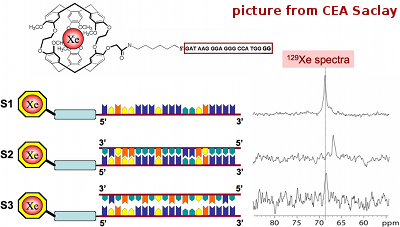Bio-sensoring with xenon-cryptophane complexes.
Recent developments to functionalize cryptophanes stimulated the development of new molecules for the encapsulation of xenon for biomedical imaging by NMR. Hyperpolarized 129Xe NMR can detect low-concentration analytes by means of a xenon-biosensor that consists in a water-soluble cryptophane-A that encapsulates the xenon. In collaboration with the group of A. Pines (Berkeley), we used a biotinylated xenon-cryptophane complex to assess the various parameters (conformational change, xenon exchange, etc) that interfere when the biosensor interact with a protein target (ChemBioChem, 2006).

A cryptophane made of a nucleotide strand grafted on a cryptophane-A moiety was synthesized for the detection of specific nucleotide targets. The bio-sensor thus obtained was able to bind xenon that was able to detect the complementary nucleotide in the micromolar range using laser-polarized 129Xe NMR spectroscopy. This work was conducted in collaboration with the NMR laboratory in CEA Saclay and with the bioMerieux-CNRS laboratory in the ENS-Lyon (ChemPhysChem, 2007).



